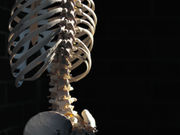
Finds insufficient evidence on balance of benefits and harms of screening asymptomatic 10- to 18-year-olds
TUESDAY, Jan. 9, 2018 (HealthDay News) — The U.S. Preventive Services Task Force (USPSTF) has concluded that the current evidence is insufficient to assess the balance of benefits and harms of screening for adolescent idiopathic scoliosis in children and adolescents aged 10 to 18 years. The recommendation statement has been published in the Jan. 9 issue of the Journal of the American Medical Association.
Researchers from the USPSTF reviewed the evidence relating to the benefits and harms of screening for and treatment of adolescent idiopathic scoliosis to update the 2004 recommendation on screening of asymptomatic adolescents.
The researchers found that there was no direct evidence on screening for adolescent idiopathic scoliosis and health outcomes or evidence relating to the harms of screening. The evidence relating to treatment with exercise and surgery was inadequate. Adequate evidence was found that treatment with bracing may slow progression of curvature in adolescents with mild or moderate curvature severity; however, inadequate evidence was found on the correlation between reduction in spinal curvature in adolescence and long-term health outcomes in adulthood. There was also inadequate evidence on the harms of treatment. Based on these findings, the USPSTF concludes that the current evidence is insufficient to determine the balance of benefits and harms of adolescent idiopathic scoliosis screening.
“Our review of the current evidence has pointed to more questions than answers about the benefits and harms of screening children and teenagers with no symptoms of scoliosis,” USPSTF member Alex R. Kemper, M.D., M.P.H., said in a statement.
Copyright © 2018 HealthDay. All rights reserved.







